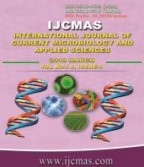


 National Academy of Agricultural Sciences (NAAS)
National Academy of Agricultural Sciences (NAAS)

|
PRINT ISSN : 2319-7692
Online ISSN : 2319-7706 Issues : 12 per year Publisher : Excellent Publishers Email : editorijcmas@gmail.com / submit@ijcmas.com Editor-in-chief: Dr.M.Prakash Index Copernicus ICV 2018: 95.39 NAAS RATING 2020: 5.38 |
Cumin (Cuminum cyminum) is an important low volume high value seed spices grown in India. India is the largest producer and consumer of cumin seed in the world while Gujarat is leading in production and Rajasthan in acreage (Table 1). Cumin is grown on 104828 ha area with an annual production of 28410 tonnes in Barmer district with an average productivity of 348 kg/ha. About 90% of the total production is marketed in Krishi Upaj Mandis of adjoining state i.e. Unjha, Deesa, Mehsana etc of Gujarat instead of Rajasthan. The yield of cumin crop is adversely affected by incidence of wilt and blight diseases and attack of aphid while economic returns were drastically affected by marketing problems. Besides this, farmers practicing traditional method of cultivation since a long time resulted in decrease in productivity. In view of this a study was conducted in three village of Gudamalani tehsil of Barmer district in Rajasthan. A set of personnel interview, questionnaire and farm inventory were used to collect basic information and production and marketing constraints from these selected farmers. The variables were scored according to scale already developed and in-use in the extension research studies. The data were analyzed and interpreted in terms of frequencies, percentage and score value. The farmers ranked different constraints like the non declaration of minimum support prizes, unavailability of storage structures, unavailability of loaning facilities, lack of laboratory for testing the seed for quality parameters, lack of processing units etc. are as major constraints and they were ranked 1, 2,…. and so on respectively.
 |
 |
 |
 |
 |